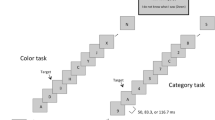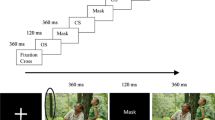Abstract
Superiority in visual search for individuals diagnosed with autism spectrum disorder (ASD) is a well-reported finding. We administered two visual search tasks to individuals with ASD and matched controls. One showed no difference between the groups, and one did show the expected superior performance for individuals with ASD. These results offer an explanation, formulated in terms of load theory. We suggest that there is a limit to the superiority in visual search for individuals with ASD, related to the perceptual load of the stimuli. When perceptual load becomes so high that no additional task-(ir)relevant information can be processed, performance will be based on single stimulus identification, in which no differences between individuals with ASD and controls have been demonstrated.



Similar content being viewed by others

References
Almeida, R. A., Dickinson, J. E., Maybery, M. T., Badcock, J. C., & Badcock, D. R. (2010). A new step towards understanding Embedded Figures Test performance in the autism spectrum: The radial frequency search task. Neuropsychologia, 48(2), 374–381. doi:10.1016/j.neuropsychologia.2009.09.024.
Bach, M. (1996). The Freiburg Visual Acuity Test-automatic measurement of visual acuity. Optometry and Vision Science, 73(1), 49.
Baldassi, S., Pei, F., Megna, N., Recupero, G., Viespoli, M., Igliozzi, R., et al. (2009). Search superiority in autism within, but not outside the crowding regime. Vision Research, 49(16), 2151–2156. doi:10.1016/j.visres.2009.06.007.
Baron-Cohen, S., Wheelwright, S., Skinner, R., Martin, J., & Clubley, E. (2001). The autism-spectrum quotient (AQ): Evidence from asperger syndrome/high-functioning autism, malesand females, scientists and mathematicians. Journal of Autism and Developmental Disorders, 31(1), 5–17. doi:10.1023/A:1005653411471.
Bayliss, A. P., & Kritikos, A. (2010). Brief report: Perceptual load and the autism spectrum in typically developed individuals. Journal of Autism and Developmental Disorders, 41(11), 1573–1578. doi:10.1007/s10803-010-1159-8.
Bertone, A., Mottron, L., Jelenic, P., & Faubert, J. (2005). Enhanced and diminished visuo-spatial information processing in autism depends on stimulus complexity. Brain, 128, 2430–2441. doi:10.1093/brain/awh561.
Constable, P. A., Solomon, J. A., Gaigg, S. B., & Bowler, D. M. (2010). Crowding and visual search in high functioning adults with autism spectrum disorder. Clinical Optometry, 93. doi:10.2147/OPTO.S11476.
Dakin, S., & Frith, U. (2005). Vagaries of visual perception in autism. Neuron, 48(3), 497–507. doi:10.1016/j.neuron.2005.10.018.
De Jonge, M. V., Kemner, C., de Haan, E. H., Coppens, J. E., van den Berg, T. J. T. P., & van Engeland, H. (2007). Visual information processing in high-functioning individuals with autism spectrum disorders and their parents. Neuropsychology, 21(1), 65–73. doi:10.1037/0894-4105.21.1.65.
Elsabbagh, M., Volein, A., Csibra, G., Holmboe, K., Garwood, H., Tucker, L., et al. (2009). Neural correlates of eye gaze processing in the infant broader autism phenotype. Biological Psychiatry, 65(1), 31–38. doi:10.1016/j.biopsych.2008.09.034.
Hooge, I. T. C., & Erkelens, C. J. (1999). Peripheral vision and oculomotor control during visual search. Vision Research, 39(8), 1567–1575. doi:10.1016/S0042-6989(98)00213-2.
Jarrold, C., Gilchrist, I. D., & Bender, A. (2005). Embedded figures detection in autism and typical development: Preliminary evidence of a double dissociation in relationships with visual search. Developmental Science, 8(4), 344–351. doi:10.1111/j.1467-7687.2005.00422.x.
Joseph, R. M., Keehn, B., Connolly, C., Wolfe, J. M., & Horowitz, T. S. (2009). Why is visual search superior in autism spectrum disorder? Developmental Science, 12(6), 1083–1096. doi:10.1111/j.1467-7687.2009.00855.x.
Kaldy, Z., Kraper, C., Carter, A. S., & Blaser, E. (2011). Toddlers with autism spectrum disorder are more successful at visual search than typically developing toddlers. Developmental Science, 14(5), 980–988. doi:10.1111/j.1467-7687.2011.01053.x.
Kemner, C., Ewijk, L., Engeland, H., & Hooge, I. (2007). Brief report: Eye movements during visual search tasks indicate enhanced stimulus discriminability in subjects with PDD. Journal of Autism and Developmental Disorders, 38(3), 553–557. doi:10.1007/s10803-007-0406-0.
Lavie, N. (1995). Perceptual load as a necessary condition for selective attention. Journal of Experimental Psychology: Human Perception and Performance, 21(3), 451–468. doi:10.1037/0096-1523.21.3.451.
Lavie, N. (2005). Distracted and confused?: Selective attention under load. Trends in Cognitive Sciences, 9(2), 75–82. doi:10.1016/j.tics.2004.12.004.
Lavie, N., & Cox, S. (1997). On the efficiency of visual selective attention: Efficient visual search leads to inefficient distractor rejection. Psychological Science, 8(5), 395–396. doi:10.1111/j.1467-9280.1997.tb00432.x.
Lavie, N., & Fockert, J. W. (2003). Contrasting effects of sensory limits and capacity limits in visual selective attention. Perception & Psychophysics, 65(2), 202–212. doi:10.3758/BF03194795.
Lavie, N., Hirst, A., de Fockert, J. W., & Viding, E. (2004). Load theory of selective attention and cognitive control. Journal of Experimental Psychology: General, 133(3), 339–354. doi:10.1037/0096-3445.133.3.339.
Lord, C., Rutter, M., & Couteur, A. (1994). Autism diagnostic interview-revised: A revised version of a diagnostic interview for caregivers of individuals with possible pervasive developmental disorders. Journal of Autism and Developmental Disorders, 24(5), 659–685. doi:10.1007/BF02172145.
Lord, C., Rutter, M., Goode, S., Heemsbergen, J., Jordan, H., Mawhood, L., et al. (1989). Autism diagnostic observation schedule: A standardized observation of communicative and social behavior. Journal of Autism and Developmental Disorders, 19(2), 185–212. doi:10.1007/BF02211841.
Merin, N., Young, G. S., Ozonoff, S., & Rogers, S. J. (2006). Visual fixation patterns during reciprocal social interaction distinguish a subgroup of 6-month-old infants at-risk for autism from comparison infants. Journal of Autism and Developmental Disorders, 37(1), 108–121. doi:10.1007/s10803-006-0342-4.
O’Riordan, M. A. (2004). Superior visual search in adults with autism. Autism, 8(3), 229–248. doi:10.1177/1362361304045219.
O’Riordan, M. A., Plaisted, K. C., Driver, J., & Baron-Cohen, S. (2001). Superior visual search in autism. Journal of Experimental Psychology: Human Perception and Performance, 27(3), 719–730. doi:10.1037/0096-1523.27.3.719.
Pellicano, E., Smith, A. D., Cristino, F., Hood, B. M., Briscoe, J., & Gilchrist, I. D. (2011). Children with autism are neither systematic nor optimal foragers. Proceedings of the National Academy of Sciences, 108(1), 421–426. doi:10.1073/pnas.1014076108.
Plaisted, K., O’Riordan, M., & Baron-Cohen, S. (1998a). Enhanced visual search for a conjunctive target in autism: A research note. Journal of Child Psychology and Psychiatry, 39(5), 777–783. doi:10.1111/1469-7610.00376.
Plaisted, K., O’Riordan, M., & Baron-Cohen, S. (1998b). Enhanced discrimination of novel, highly similar stimuli by adults with autism during a perceptual learning task. Journal of Child Psychology and Psychiatry, 39(5), 765–775. doi:10.1111/1469-7610.00375.
Remington, A., Swettenham, J., Campbell, R., & Coleman, M. (2009). Selective attention and perceptual load in autism spectrum disorder. Psychological Science, 20(11), 1388–1393. doi:10.1111/j.1467-9280.2009.02454.x.
Remington, A. M., Swettenham, J. G., & Lavie, N. (2012). Lightening the load: Perceptual load impairs visual detection in typical adults but not in autism. Journal of Abnormal Psychology, 121(2), 544–551. doi:10.1037/a0027670.
Simmons, D. R., Robertson, A. E., McKay, L. S., Toal, E., McAleer, P., & Pollick, F. E. (2009). Vision in autism spectrum disorders. Vision Research, 49(22), 2705–2739. doi:10.1016/j.visres.2009.08.005.
Acknowledgments
We thank Branka Milivojevic, Emmie van Schaffelaar, Manje Brinkhuis, Carlijn van den Boomen, and Esther Eijlers for their help with participant recruitment and data collection, and Siarhei Uzunbajakau for building the experimental setup. This work was supported by a Netherlands Organization for Scientific Research (NWO) VICI Grant (45307004) to Chantal Kemner.
Conflict of interest
The authors declare that they have no conflict of interest.
Author information
Authors and Affiliations
Corresponding author
Rights and permissions
About this article
Cite this article
Hessels, R.S., Hooge, I.T.C., Snijders, T.M. et al. Is There a Limit to the Superiority of Individuals with ASD in Visual Search?. J Autism Dev Disord 44, 443–451 (2014). https://doi.org/10.1007/s10803-013-1886-8
Published:
Issue Date:
DOI: https://doi.org/10.1007/s10803-013-1886-8



